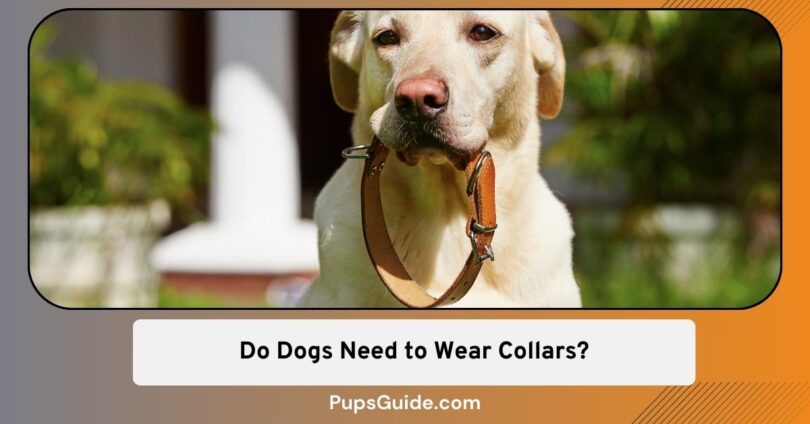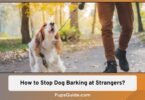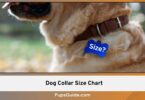Dogs are undoubtedly man’s best friend, but the responsibilities that come with their companionship extend beyond providing love, shelter, and food. One of the questions that often arises in the realm of pet ownership is whether or not dogs need to wear collars.
The answer to this seemingly simple query is multifaceted, involving elements of legality, safety, and personal preference.
5 Reasons Why Dogs Need To Wear Collars
Let’s explore the reasons why your dog may need a collar, from legal requirements to emergencies and everyday convenience.
1. Legal Requirements and Identification
One of the most compelling reasons for your dog to wear a collar is rooted in legality. In many areas, it is not just a recommendation but a legal requirement for dogs to wear collars with proper identification. Failure to comply with this mandate can result in hefty fines from your local animal control authority.
These identification measures usually entail attaching tags to your dog’s collar. These tags typically include your dog’s name, your contact information, and, in some cases, a license or registration number.
These tags serve as a quick and easy way for anyone who finds your lost dog to contact you and facilitate a timely reunion. In urban and suburban areas, this requirement is especially common, reflecting the higher population density and potential for dogs to wander or get lost.
Not only does complying with this legal requirement help you avoid penalties, but it also ensures the safety and well-being of your furry friend.
In the unfortunate event that your dog escapes or becomes lost, the collar and identification tags become vital tools for reuniting you with your beloved pet. This is a situation where you will be immensely grateful that your dog has their ID securely placed around their neck.
2. Emergency Situations
The need for a collar on your dog becomes even more apparent in emergency situations. When disaster strikes and families are forced to evacuate their homes, the chaos and confusion can make it difficult to ensure the safety of your pets. Natural disasters such as tornadoes, storms, wildfires, or sudden evacuations can cause distress and panic among dogs, leading them to flee from their homes in search of safety.
In these high-stress situations, dogs may behave unpredictably and venture far from their familiar territory. If your dog is not wearing a collar with proper identification, it becomes challenging for rescuers or Good Samaritans to identify them and return them to you.
Consider a scenario where a wildfire is rapidly approaching your neighborhood. In the rush to evacuate, you may not have the time to gather your pet’s leash, harness, or any other accessories.
However, if your dog has a collar with identification tags, they have a much better chance of being reunited with you, even if you are separated during the chaos of evacuation. It is a small, but potentially life-saving, measure to ensure your pet’s safety during emergencies.
3. Everyday Convenience and Safety
Beyond legal requirements and emergencies, there are other important reasons why dogs should wear collars in their day-to-day lives. Collars provide a sense of control and safety when you take your dog for walks or outings. Here are a few reasons why collars are beneficial for everyday convenience and safety:
a. Leash Attachment
Collars typically have a built-in ring or attachment point where you can securely attach a leash. This attachment allows you to have control over your dog when you are out for a walk, preventing them from running off or getting into potentially dangerous situations.
b. Training and Identification
When you are training your dog, a collar provides a useful point of control for commands and redirection. Additionally, it can serve as a visual cue to your dog that it’s time for a walk or a training session.
c. Visual Identification
A collar can be a quick way for people to identify that a dog has an owner. It sends a signal that the dog is not a stray, which can help avoid misunderstandings and potentially stressful interactions with other dogs or people.
d. Medical Information
Some pet owners choose to include medical information or alert tags on their dog’s collar. For instance, a tag indicating that your dog has a specific medical condition or allergy can be a valuable piece of information for anyone who may encounter your pet while you’re out and about.
4. Personalized Identification and Style
While practical considerations like legality and safety are paramount, many pet owners also use collars as a means of personal expression and style. Collars come in a wide array of designs, materials, and colors, allowing owners to choose a collar that reflects their dog’s personality or their own aesthetic preferences.
Personalized collars, engraved with your dog’s name and your contact information, not only serve the functional purpose of identification but can also be a fashion statement.
These collars allow your dog to stand out and be easily recognizable while showing off their unique style. With the vast selection of collars available, you can find one that suits your dog’s character, whether they are rugged and outdoorsy or elegant and refined.
In addition to aesthetics, there are specialized collars designed for various purposes. For example, if your dog tends to pull on the leash during walks, a no-pull harness collar can help distribute the pressure more evenly, making walks more comfortable for both you and your dog.
Similarly, there are collars designed to deter fleas and ticks, adding another layer of protection for your pet’s health.
5. Alternative Identification Methods
While collars are a popular and effective means of identification, they are not the only option. Some pet owners opt for microchipping as an alternative or complementary method of identification.
A microchip is a small, implantable device that is typically injected under your dog’s skin between the shoulder blades. When scanned, it reveals a unique identification number that is linked to your contact information in a database.
Microchips have the advantage of being permanent and tamper-proof, unlike collars that can be removed by determined dogs or strangers. However, they require specialized equipment to be scanned, which may not be readily available to the average person who encounters your lost pet.
A common and practical approach is to combine both a collar with identification tags and a microchip. This redundancy provides added security and peace of mind, ensuring that even if one form of identification is lost or fails, there is still another means of reuniting you with your dog.
Takeaway:
- Legal requirements, such as identification tags, are essential for complying with local regulations and ensuring the safety of your pet.
- In emergency situations, collars become invaluable in reuniting lost dogs with their owners during chaotic evacuations or natural disasters.
- Collars also offer everyday convenience and safety by providing leash attachment, aiding in training, and offering visual identification.
How To Ensure A Snug Fit?
Ensuring a snug fit for your dog’s collar is essential for their safety and comfort. A properly fitted collar should be snug enough to stay in place but not so tight that it causes discomfort or restricts your dog’s movement or breathing. Here’s how to ensure a snug fit for your dog’s collar:
1. Measure Your Dog’s Neck
Before purchasing a collar, measure your dog’s neck accurately. Use a flexible measuring tape or a piece of string, then measure the string with a ruler or a tape measure. Make sure to measure around the base of your dog’s neck, where it is the widest.
2. Use the Right Size
Once you have your dog’s neck measurement, choose a collar size that matches or is slightly larger than the measurement. Most collars are adjustable and have a range of sizes, so select the size that allows you to fit two fingers between the collar and your dog’s neck.
3. Adjust the Collar
If your dog’s collar is adjustable, you can fine-tune the fit to ensure it’s snug but not tight. Follow these steps:
- Put the collar around your dog’s neck, with the buckle or fastening point on the top or side.
- Adjust the collar’s length to achieve a snug fit. You should be able to comfortably slide two fingers (usually your index and middle fingers) between the collar and your dog’s neck. This ensures that it’s not too tight but won’t slip over your dog’s head.
- Ensure that the excess collar length is trimmed or tucked away to prevent your dog from chewing on it.
4. Check Regularly
Collars may loosen over time due to wear and tear. It’s important to check your dog’s collar periodically to make sure it’s still snug and secure. If you notice that the collar has become too loose, readjust it to maintain a proper fit.
5. Observe Your Dog
Pay attention to your dog’s behavior and comfort. Signs that the collar is too tight include difficulty breathing, choking, or your dog pawing at or scratching their neck. If you notice any of these signs, immediately loosen the collar.
6. Choose the Right Type of Collar
Different types of collars may have specific fitting requirements.
For example, a martingale collar, which is often used for dogs that tend to slip out of traditional collars, should be adjusted so it can tighten without choking your dog when they pull. Harnesses, on the other hand, should fit snugly but not too tightly around your dog’s body.
7. Monitor Puppies and Growing Dogs
Puppies can grow quickly, so it’s essential to monitor their collar fit regularly. You may need to adjust or replace the collar as your puppy grows. Be especially attentive during the puppy’s growth phase.
8. Consider Special Needs
Some dogs have unique needs, such as those with medical conditions or special training requirements. In such cases, consult with a veterinarian or a professional dog trainer to determine the best collar type and fit for your dog.
9. Remove the Collar When Unsupervised
For safety, consider removing your dog’s collar when they are unsupervised in a secure area. This reduces the risk of the collar getting caught on objects, which could lead to injury or choking.
Takeaway:
- Ensuring a snug fit for your dog’s collar is crucial for their well-being and safety.
- It prevents the collar from slipping off or causing discomfort, making walks and identification more secure for your furry friend.
- Regularly inspect the collar’s fit, especially during your dog’s growth or if you notice any changes in their behavior.
Which Collar Type To Use In Which Situation?
Selecting the appropriate collar type for your dog depends on their specific needs, behavior, and your training goals. It’s essential to choose a collar that aligns with your dog’s well-being and training requirements.
Below, I’ll outline various collar types and the situations in which they are commonly used.
1. Standard Flat Collar
- Suitable for: Standard flat collars are the most common choice for everyday wear and identification. They are suitable for well-behaved dogs and provide a place to attach ID tags and a leash.
- Not Suitable for: Dogs that tend to pull on the leash or slip out of their collars. These collars may not be effective for training purposes.
2. Martingale Collar
- Suitable for: Martingale collars are designed for dogs that tend to slip out of standard collars or have necks larger than their heads. They provide gentle control without choking the dog.
- Not Suitable for: Martingale collars should not be left on unsupervised dogs, as they can pose a risk if the dog gets caught on an object.
3. Prong or Pinch Collar
- Suitable for: Prong or pinch collars are designed for dogs that are strong pullers and difficult to control on a regular collar. They provide a correction when the dog pulls.
- Not Suitable for: These collars should only be used under the guidance of a professional dog trainer, as they can cause discomfort if not used correctly.
4. Choke Chain Collar
- Suitable for: Choke chains are used for training purposes, often by experienced trainers. They provide a quick correction when the leash is pulled.
- Not Suitable for: Choke chains can be harmful if misused, so they should be used with caution and expertise. They are not ideal for everyday wear or casual walking.
5. Shock Collar (E-Collar)
- Suitable for: Shock collars are sometimes used for specific training purposes, such as remote training, bark control, or invisible fence containment. They deliver a mild electric stimulation as a correction.
- Not Suitable for: Shock collars should only be used under the guidance of a professional dog trainer, and alternative training methods should be considered first. They are not suitable for everyday wear.
7. Bark Collar
- Suitable for: Bark collars are designed to discourage excessive barking by providing a stimulus, which can be sound, vibration, or a mild electric shock.
- Not Suitable for: Bark collars should be used cautiously and as a last resort for dogs with chronic barking issues. Consult with a veterinarian or a professional trainer before using one.
Understand here; Shock Collars and Bark Collars – Which One is Right for You?
How Many Hours Should You Use A Collar?
The duration for which a dog should wear a collar depends on the specific situation and the type of collar being used. Here are some guidelines on how long a dog can wear a collar:
1. Everyday Collar
For standard, everyday collars, it is generally safe for your dog to wear them continuously, as long as they are properly fitted and comfortable. Most dogs wear their everyday collars all day and night.
However, it is recommended to periodically check the collar for proper fit, especially for growing puppies, to ensure it doesn’t become too tight. Regularly inspect the collar for signs of wear and tear, and replace it as needed to prevent any breakage or accidents.
2. Training Collars
Training collars, such as martingale collars, choke chains, prong collars, and shock collars, should not be left on your dog for extended periods. These collars are designed for training and correction during specific training sessions.
Ideally, you should only use training collars during training sessions or walks and remove them once the session is over. Leaving them on continuously can cause discomfort and potentially harm your dog.
3. Bark Collars
Bark collars, which are used to deter excessive barking, should only be worn when the dog is likely to engage in excessive barking, such as during the day when you’re not at home. These collars should not be worn constantly, as they are intended for specific training purposes.
4. Specialized Collars
Collars designed for specific purposes, such as GPS tracking collars or flea and tick collars, should be used as directed by the manufacturer. Follow the recommended usage instructions provided with these collars.
5. Prong and Choke Collars
These should be used with caution, and ideally, under the guidance of a professional dog trainer. They are not designed for continuous wear but rather for controlled, supervised training sessions.
Takeaway:
- It is generally safe for your dog to wear an everyday collar continuously, provided that it is properly fitted and regularly checked for any signs of discomfort or wear.
- However, training collars, bark collars, and specialized collars should be used only when necessary for their intended purposes and should be removed when not in use.
What Are The Problems That Could Arise From The Misuse Of Collars?
The misuse of dog collars can lead to various problems, including physical discomfort, behavioral issues, and, in extreme cases, injury to the dog.
1. Physical Discomfort and Pain
An improperly fitted collar, especially a choke chain or prong collar, can cause choking or strangulation when the dog pulls or tugs on the leash. This can result in severe neck injuries and even loss of consciousness.
Collars that are too tight or left on for extended periods can cause skin irritation, friction burns, and sores. This can lead to discomfort and skin infections.
2. Behavioral Problems
The misuse of aversive collars, such as shock collars, can lead to aggression and fear in dogs. Dogs may associate pain or discomfort with certain situations or people, leading to aggressive behavior or anxiety.
Reactive Behavior: Incorrect use of training collars like choke chains or prong collars can cause dogs to become more reactive and anxious, which may exacerbate behavior problems rather than resolve them.
3. Ineffective Training
Miscommunication: If training collars are not used properly, they can lead to confusion and miscommunication between the owner and the dog. This can hinder the effectiveness of training efforts and lead to frustration for both the dog and the owner.
Negative Associations: A dog may associate the discomfort caused by a misused collar with the training process, which can result in a reluctance to learn and obey commands.
4. Physical Injuries
Nerve Damage: Improperly fitted or excessively tight collars, particularly prong collars or shock collars, can cause nerve damage in the neck, leading to long-term pain and physical issues.
Tracheal Damage: Collars that put excessive pressure on the trachea can lead to tracheal damage, which can result in breathing difficulties and long-term health problems.
5. Escape and Loss
Slipping Out of Collars: Dogs can escape from improperly fitted collars, especially if they are not adjusted correctly. This can lead to the dog getting lost or injured if they run into traffic or dangerous situations.
Collar Breakage: Low-quality collars or collars that are worn and damaged can break, allowing the dog to escape.
6. Psychological Stress:
Fear and Anxiety: The improper use of aversive collars or harsh corrections can lead to fear and anxiety in dogs, impacting their overall well-being and mental health.
7. Diminished Trust
Misusing collars can erode the trust between you and your dog. Your dog may become fearful or anxious around you, making it difficult to build a positive and cooperative relationship.
Key Takeaways:
- It’s crucial for dog owners to educate themselves on proper collar usage and, when necessary, seek guidance from professional dog trainers.
- Additionally, monitoring your dog for any signs of discomfort, injury, or behavioral changes related to collar use is essential.
- Collars, when used correctly and responsibly, can be valuable tools for identification and control, but misuse can result in harm to your beloved pet.
- Always prioritize your dog’s safety and well-being when choosing and using a collar.
Do Dogs Need to Wear Collars? – Conclusion
Let’s wrap up this collar conversation in plain and simple terms. We’re talking about whether your dog should rock a collar, and the answer ain’t black and white. It’s a mix of rules, safety, and what you and your dog like.
Misusing collars, like having a too-tight fit, can cause your dog all sorts of trouble. Choking, skin irritation, and even nerve damage – it’s like a bad day at the office for your furry friend. Plus, your dog might start to see you as the “bad cop,” and who wants that?
So, choose your dog’s collar wisely, and keep an eye on it. In the end, your dog’s collar is like their personal ID and style statement, but it comes with responsibilities. Do it right, and you’ll keep your best buddy safe and stylin’. It’s a win-win!








Leave a Comment